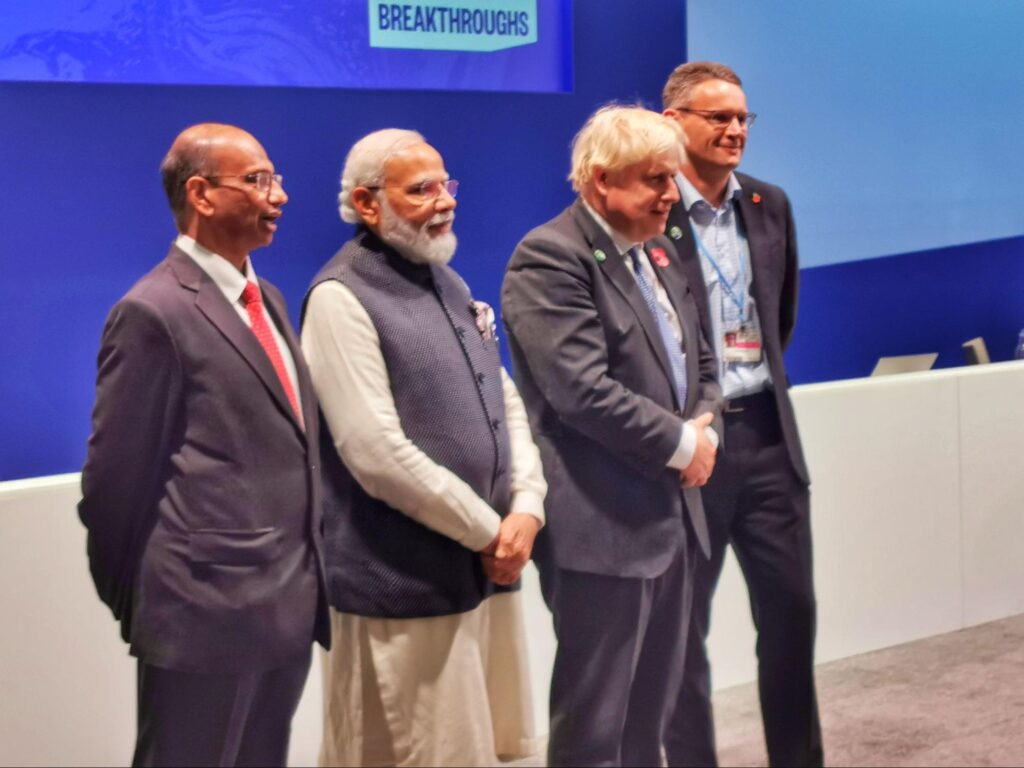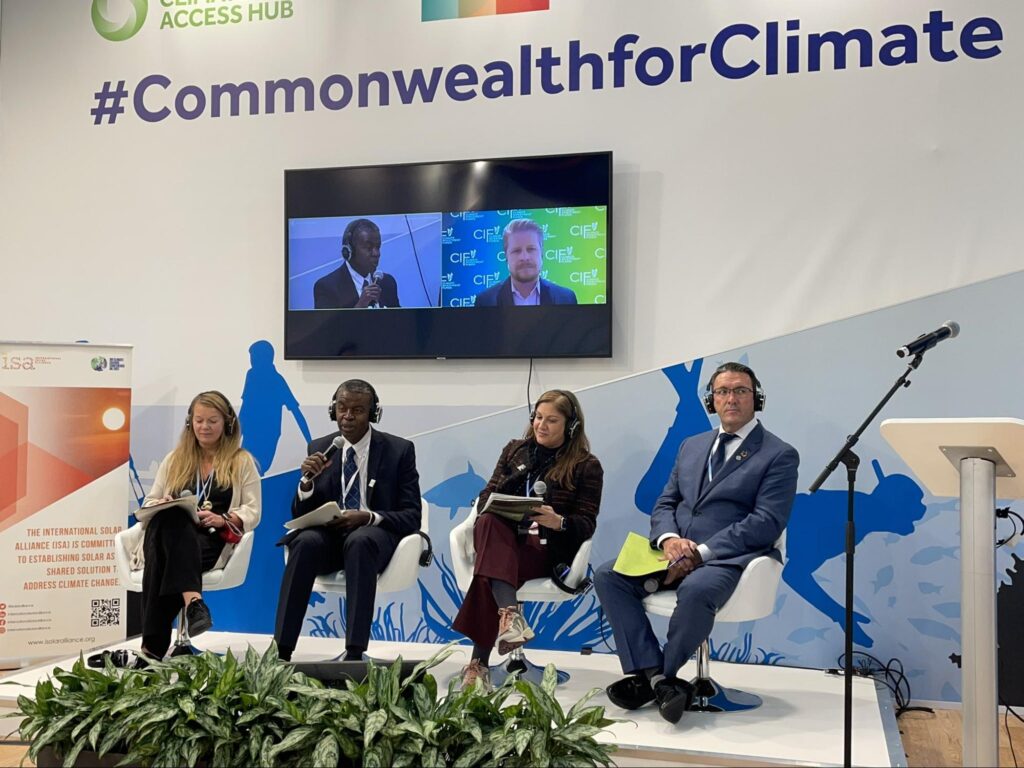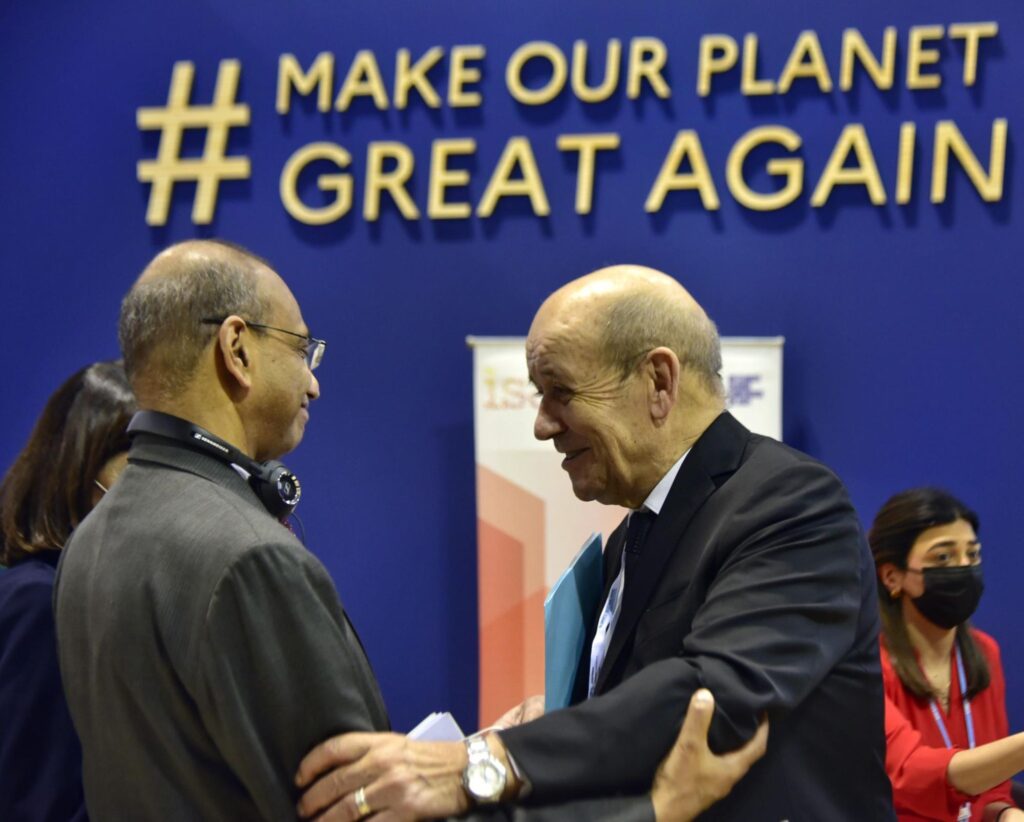This article is produced under the aegis of Climate Tracker’s Online COP26 Climate Justice Journalism Fellowship, awarded to The Bastion’s Environment Lead Vaishnavi Rathore. To read the rest of her coverage under this fellowship, click here.
As COP26 progresses, climate finance and phasing out the usage of coal are two themes that have found themselves in the spotlight. In the first week of the climate negotiations, between 31 October and 7 November, the International Solar Alliance (ISA), through various announcements, merged the goals of the two.
The ISA, launched at COP21 held in Paris, is an international alliance co-initiated by India with 90 signatories and 193 prospective members. Its mission is “working towards making solar energy available 24×7 at affordable cost [sic] to all.”
Yesterday, the ISA, in partnership with World Resources Institute and Bloomberg Philanthropies, continued the momentum by holding a series of discussions with public and private solar and finance experts in a side event at COP26. The event also marked the launch of the Solar Investment Action Agenda, which focuses on strategies to scale up solar investments to US$1 trillion. “If you want to build a [solar] movement, how do you finance that? That is what we are talking about here, and that is what the launch of this Action Agenda is,” Ani Dasgupta, President and CEO, WRI said at the event held last evening.
“Developing and emerging economies, who are home to nearly two-thirds of the world’s population, have received only 20% of global renewable energy investments so far. To put the world on track for global net zero emissions by 2050, the annual clean energy investment in developing countries needs to increase by more than seven times,” says Jagjeet Sareen, the Assistant Director-General (Strategy) at the International Solar Alliance Secretariat, in an email exchange with The Bastion. Sareen works at the World Bank Headquarters in the United States, and is temporarily transferred to the ISA Secretariat in Gurugram, India. At the World Bank, he served as a Senior Policy Officer at the Climate Investment Funds.
To increase annual clean energy investments, he says, priority has to be given to mobilising investment flows to countries with the highest energy poverty, or those with a lack of access to affordable sustainable energy. So far, ISA has made various announcements at COP26 in this direction. On 3 November, ISA announced the unlocking of US$100 billion in public and private capital to provide one billion people with reliable, renewable energy, avert four billion tons of carbon emissions, and create more than 150 million jobs.
The day before, it raised the curtains of the ‘Green Grid Initiative – One Sun One World One Grid’ (GGI-OSOWOG). The GGI-OSOWOG aims to be the world’s first international network of global interconnected solar grids, while also working towards mobilising US$1 trillion worth of funding by 2030 to assist developing countries in expanding their solar power grid.

The Bastion‘s Vaishnavi Rathore (VR) caught up with Jagjeet Sareen (JS) to learn more about why raising investments for solar needs to be prioritised, how the inequity between the developing-developed world plays out in solar energy, and what the ISA expects to achieve through COP26 discussions.
VR: What was the objective behind launching a Solar Investment Action Agenda at this point?
JS: Scaling solar investment is urgent for meeting climate goals—as well as for providing access to affordable energy to hundreds of millions of people whose energy needs are unmet today. Over the past decade, owing to the decline in the cost of solar panels, there has also been a reduction in the cost of electricity from solar photovoltaic (PV) systems. As per the World Bank’s International Renewable Energy Agency, costs have dropped by 85% between 2010 to 2020 (from US$381/MWh to $57/MWh) and are expected to drop even further to US$10-50/MWh by 2050. This dramatic decline in the costs for solar PV technology, along with falling prices of storage systems, provides solar energy with true potential to play a huge role in climate mitigation and in lifting people out of energy poverty.
However, to realise these benefits and, thereby, achieve the global net-zero target carbon emissions, we need to work together to mobilise solar investment at unprecedented rates to ensure that our installed capacities can balance an ever-increasing demand [Editor’s note: India is targeting about 450 Gigawatt (GW) of installed renewable energy capacity by 2030, 60% of which is expected to be met from solar]. Yearly investment in solar energy needs to double in this decade alone and there needs to be a focus on deploying solar in developing and emerging economies. This will not happen on its own—there needs to be a coordinated commitment by governments, private investors, and international financial institutions to significantly ramp up solar investment and ensure its equitable distribution.
The Solar Investment Action Agenda that ISA, the World Resources Institute, and Bloomberg Philanthropies participated in at COP26 and the Solar Investment Roadmap that we will be developing next year are examples of such strategies [Editor’s note: public documentation on the same is forthcoming]. They intend to support this type of orchestrated process by strengthening coalitions and mobilising finance to scale up solar investment in line with ISA’s goal of US$1 trillion by 2030. The Roadmap also will help ensure that the necessary institutional arrangements are in place to effectively deploy the committed funding needed to deliver solar energy on the ground.
VR: Who is expected to invest in the financing of renewable energy?
JS: The numerous barriers to scaling solar investment include perceived and real financial risks, political risks, regulatory instability, and a lack of bankable projects and pipelines for investment. Proven solutions to each of these barriers do exist, however, implementing them at scale will require a concerted effort from governments, private investors, and the development finance community. Thus, accelerating solar investment and finance at the pace needed will require investment and action by all these stakeholders—these actions will reinforce each other.
The Action Agenda and Roadmap would provide an inventory of strategic elements for successfully scaling solar investment—focusing on boosting investment readiness, engaging investors, building channels of finance, supporting pipeline development, and mitigating financial risk.

To mobilise funding from private investors, especially in developing countries, public financial institutions need to provide more catalytic financing for solar development while governments need to invest in regulatory improvements to reduce risks and boost investor confidence.
Once private investment increases, it will encourage more ambitious action from governments and financing institutions. In the Solar Investment Action Agenda, we describe how this conceptualised ambition-loop can help lay the foundation for solar markets to grow and compete alongside other clean energy options by mutually reinforcing commitments and action with support from a range of enabling partners.
VR: At COP26, what are the key areas that the ISA is prioritising?
JS: We are on a mission to ‘solarize’ the world. Our objectives clearly define our plan of action, that is, enabling an energy transition of 1,000 GW solar capacity, reducing carbon emissions by 1,000 million tonnes, ensuring access [to energy] for 1,000 million people by 2030 using clean energy solutions, and mobilising US$1,000 billion in solar investments by 2030.

The Solar Investment Action Agenda aims to engage all key players in the solar energy sector—corporates, governments, financial institutions, and private investors among others—to engage in the talks of mobilising US$1 trillion in solar investments. Demonstrating successful mobilisation of investment and finance increases the appetite of both public and private actors to support capacity building, enabling policy, and regulatory reforms, as well as investment planning and allocation of public finance to catalyse private investment. The Action Agenda would play a vital role in this regard, as it provides insights from the solar finance community on actions needed to scale solar investment and deployment and identifies solar investment opportunities that can help build the global clean energy economy at the pace and scale needed.
It is our priority that these discussions at COP26 help in accelerating the momentum towards mobilising investment and achieving a solarized future with cleaner, more reliable electricity and more robust economic opportunities for all. Fully realising this vision will require public and private sector actors to align around high-impact opportunities and take mutually reinforcing actions.
VR: Given the past six years of ISA’s operations, do you think there is an inequity between the developing and developed nations of the world, in terms of financial investments available for renewable energy?
JS: Although various milestones have been achieved in the solar energy sector over the past decade, they have been centric towards developed countries.
However, solar investment has not been reaching those countries and communities that need it most. Developing and emerging economies, who are home to nearly two-thirds of the world’s population, have received only 15% of global renewable energy investments between 2013 to 2018.
This can be attributed to the various barriers encountered in unfavourable political and financial environments. The situation is especially egregious in Africa, which is home to 17% of the world’s population and also represents 75% of the world’s population that is without secure access to electricity. Africa has only received 3% in 2018 and 4% of global power supply investments in 2020.
To give you a sense of the scale of change needed, the annual clean energy investment in developing countries needs to increase by more than seven times to put the world on track for global net-zero emissions by 2050. To make this happen, we need to see commitments from the negotiators at COP26 that prioritise mobilising investment flows to the countries with the highest levels of energy poverty, and that ensure the equitable distribution of enhanced solar investment. This requires a joint effort from both private and public sector players to ensure a just transition that meets climate goals.
VR: How can these investments in solar energy help India move away from fossil fuels?
JS: India has made great strides [in renewable energy] and achieved the coveted milestone of 100 GW of installed solar energy capacity in its power sector. In doing so, it increased the share of clean renewable energy in the overall power generation mix to 38% as of July 2021. As of September 2021, India has operationalised nearly 46 GW of solar generation capacity with a similar capacity in the pipeline, which puts India on track to achieve 100 GW out of the 175 GW RE target by 2022.
With the prices of renewable electricity already competing with fossil fuel plants, the business case for renewables is already steady enough. The policies and regulations are already favorable towards the adoption of RE—the clean energy sector in India attracted about US$17 billion as investment during 2019. With this framework in place, it is just a matter of how quickly investors can pour in the funds into the sector and build assets on the ground. The average annual investments in the RE sector are anticipated to increase from US$20 to 25 billion between 2022 to 2030 to US$30 to 35 billion between 2030 to 2040. They are expected to peak at around US$50 to 60 billion by 2050. The momentum is certainly there to achieve these investment levels by 2050, but facilitating a regime that offers an affordable cost of capital could help grease the wheels. [Editor’s note: these figures are Sareen’s expert estimations.]
Along with the affordable rates, large scale foreign capital will have to supplement the domestic capital sources of funding. In this regard, an India-centric investment-specific plan and roadmap will help in laying out strategies. It can outline potential opportunities for coordinated, catalytic action to address barriers and accelerate the pace and scale of solar investment in India, thereby facilitating a move away from fossil fuels.
Featured image: (left) Kamuthi Solar Park, courtesy of Financial Express (CC BY-SA 4.0); (right) Mr. Jagjeet Sareen, courtesy of the ISA.







நல்ல மதிப்புரை வழங்கியதற்க்கு நன்றி